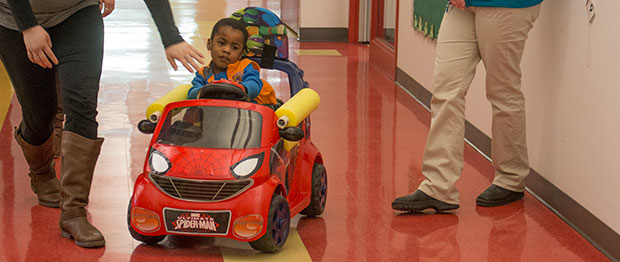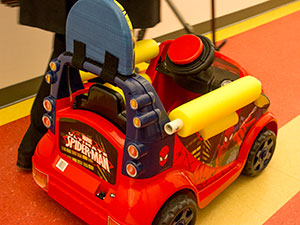
Trace Bales checked out his new “adapted car” at the Children’s Center for the Visually Impaired today. The low-cost, low-tech cars can replace powered wheelchairs for children who can’t move on their own.
Three-year-old Trace Bales got into his new car today and quickly figured out how to zip down the hallway.
The inexpensive toy car, purchased at a local store, allowed the child a level of mobility he’d never experienced before.
Amy Bales and her husband adopted Trace two weeks ago. She says he’s visually impaired, nonverbal, and has a form of cerebral palsy. Until now, the family has had to push him in his wheelchair to get him anywhere.
“Now he’ll have control over his own movement,” she says.
That’s because Trace now has a custom adapted car built jointly by students from the Rockhurst University physical therapy and engineering departments.
Physical therapy professor Kendra Gagnon says the Rockhurst project grew out of a research study at the University of Delaware called “Babies Driving Robots and Racecars.” Dr. Cole Galloway and others in Delaware first adapted robots to provide mobility to young children with cerebral palsy and other conditions.
The research showed that children who used a robotic car to get around made improvements in mobility as well as language and cognition.
But there weren’t enough robots to go around. So researchers bought inexpensive “racecars” at a toystore and set about adapting them for the children.
The Go Baby Go project is now training therapists, engineers and parents across the country to make the adaptations.
 “We can take a toy car we can get at a local store and for less than $200, make a low-tech version of a power mobility device,” Gagnon says.
“We can take a toy car we can get at a local store and for less than $200, make a low-tech version of a power mobility device,” Gagnon says.
In contrast, an electric wheelchair may cost between $10,000 and $20,000 and sometimes insurance companies are reluctant to pay for these devices for children. Families also may need to purchase specialized vans to transport the wheelchairs.
Danielle Schulte, Trace’s physical therapist at the Children’s Center for the Visually Impaired, 3101 Main Street, helped the Rockhurst students adapt this car to meets Trace’s unique needs.
CCVI has several other modified cars that families can try out before deciding if a car would be a good option for their child.
“They brought tears of joy from several families,” she says.
As for Trace, the car “integrates play in a new and exciting way,” Schulte says. “He’s now able to participate with the other kids in a new way.”



Very cool ideas and usefulness!